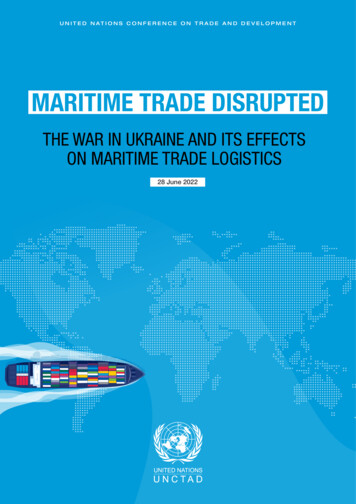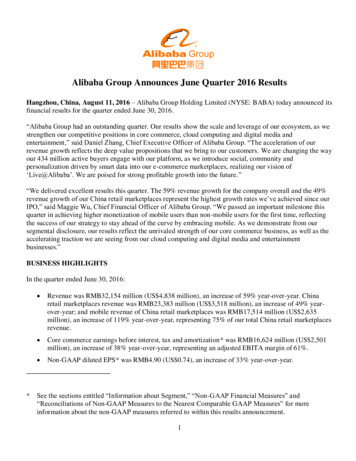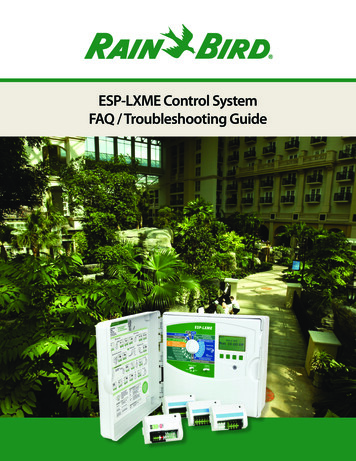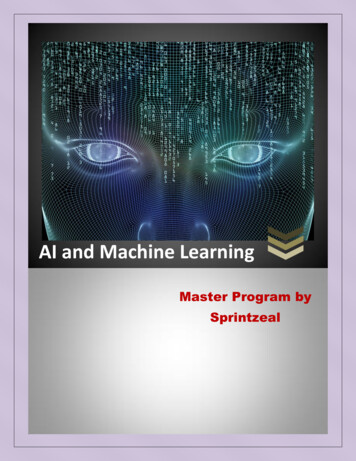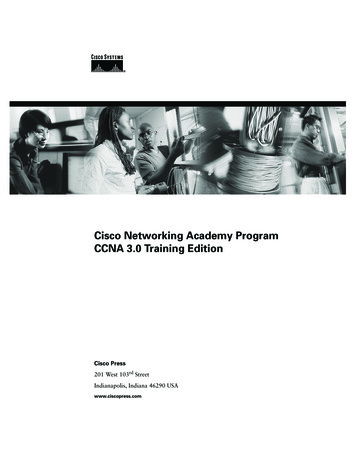
Transcription
9/ 1010TLE - Bread and PastryProduction NC IIQuarter 2 – Module 1Tools, Equipment, and BakingTerms in Pastry ProductionCO Q2 TLE10 Bread and Pastry Production Module 1
Technology and Livelihood Education – 10Quarter 2 – Module 1: Tools, Equipment, and Baking Terms in PastryProduction Alternative Delivery ModeFirst Edition, 2020Republic Act 8293, section 176 states that: No copyright shall subsist in any workof the Government of the Philippines. However, prior approval of the governmentagency or office wherein the work is created shall be necessary for exploitation ofsuch work for profit. Such agency or office may, among other things, impose as acondition the payment of royalties.Borrowed materials (i.e., songs, stories, poems, pictures, photos, brand names,trademarks, etc.) included in this module are owned by their respective copyrightholders. Every effort has been exerted to locate and seek permission to use thesematerials from their respective copyright owners. The publisher and authors do notrepresent nor claim ownership over them.Published by the Department of EducationSecretary: Leonor Magtolis BrionesUndersecretary: Diosdado M. San AntonioDevelopment Team of the ModuleWriters: Merlie C. MangannayEditors:Reviewers: Jonalyn C. Ambrona, Primo B. AligoIllustrator:Layout Artist: Bernie Rojo PamplonaManagement Team: Estela Leon-CariñoRosita C. AgnasiGeorgina C. DucaysoKhad M. LayagJocelyn P. SamidanDolores M. AnecangAtkinson F. TudlongPrinted in the Philippines byDepartment of Education –Cordillera Administrative RegionOffice Address:Telefax:E-mail @deped.gov.ph
10TLE - Bread and PastryProduction NC IIQuarter 2 – Module 1Tools, Equipment and Baking Terms inPastry Production
Introductory MessageThis Self-Learning Module (SLM) is prepared so that you, our dearlearners, can continue your studies and learn while at home. Activities,questions, directions, exercises, and discussions are carefully stated for youto understand each lesson.Each SLM is composed of different parts. Each part shall guide youstep by-step as you discover and understand the lesson prepared for you.Pre-tests are provided to measure your prior knowledge on lessons ineach SLM. This will tell you if you need to proceed on completing this moduleor if you need to ask your facilitator or your teacher’s assistance for betterunderstanding of the lesson. At the end of each module, you need to answerthe post-test to self-check your learning. Answer keys are provided for eachactivity and test. We trust that you will be honest in using these.In addition to the material in the main text, Notes to the Teacher arealso provided to our facilitators and parents for strategies and reminders onhow they can best help you on your home-based learning.Please use this module with care. Do not put unnecessary marks onany part of this SLM. Use a separate sheet of paper in answering the exercisesand tests. And read the instructions carefully before performing each task.If you have any questions in using this SLM or any difficulty inanswering the tasks in this module, do not hesitate to consult your teacheror facilitator.Thank you.iii
Lesson1Tools, Equipment, andBaking Terms in PastryProductionWhat I Need to KnowThis module was designed and written with you in mind. It is here to help youmaster the concepts of bread and pastry production. The scope of this modulepermits it to be used in many different learning situations. The language usedrecognizes your vocabulary level. The lessons are arranged to follow the standardsequence of the course. But the order in which you read them can be changed tocorrespond with the textbook you are now using. This module provides you thenecessary information and activities to enrich your knowledge and skills in preparingand presenting pastries.Lesson 1 –Tools, Equipment and Baking Terms in Pastry ProductionAfter going through this module, you are expected to:1. identify tools and equipment used in pastry production;2. demonstrate how to use tools and equipment in pastry production; and,3. familiarize self and explain pastries and baking terms related to pastryproduction.Before going through this module, youmust answer first the activity below.llustration by: CLPC1
What I KnowActivity 1: Break the CodeDirections: Use the key below to help you break the code and to complete thesentences below. Write your answer on a separate sheet of paper.123451ABCDE2FGHIJ3KLMNO4PQRST5UVWXY6Z,./-1. In baking pastries you need to monitor your baking time.45 24 33 15 432. The oven should have35 52 153445 15 33 41 15 43 11 45 51 43153. You should use to measure small33 15 11 44 51 43 24 34 2244 41 35 35 34amount of baking powder and salt.4. is used to slice and chopped fruits in making21 43 15 34 13 2331 34 24 52 15fruit pie.5. You need to stamp out individual cookiesfrom4413 35 35 31 24 1513 51 45 45 15 43rolled dough.6. In decorating pastries, is used to come up with41 11 44 45 43 5545 24 41 44different design of frosting.7. is done by pinching the sides and tops of pie or tart crust.13 43 24 33 418. The product that is highly proportioned by fat to flour with a little amount ofwater is .41 11 44 45 43559. You need to the crème patisserie into the creampuff.41 24 44 1535 51 4 52
10. To slash the surface of pie dough with knife is to .44 13 35 43 1511. The length of time that a product is fit for consumption is called- .44 23 15 32 2132 24 21 1512. To fold laminated dough into thirds like a letter to incorporate fats is.45 23 43 15 1521 35 32 1413. To prepare pizza in advance you can the crust andtop12 11 31 1512 32 24 34 14needed ingredients and bake again for 10 minutes.14. In rolling dough, is needed to attain the desired shape41 11 44 45 43 5533 11 45and size of dough.15. is used to cut dough in scaling.14 35 51 22 2313 51 45 45 15 43What’s InIn the past lessons you have met the different baking terms used in preparingand presenting different breads. Same with pastry production you will encounterculinary and technical terms related to pastries and you will learn also the neededtools and equipment in preparing and presenting pastries. Are you ready to learnthose things? But before that let’s see if you can still remember what you have learnedthese past lessons and relate to our topic today by answering the questions below.True or FalseDirections: Write TRUE if the statement is correct and FALSE if it is wrong. Writeyour answer on a separate sheet of paper.1. Rolling pin is used in flattening dough of bread and pastry.2. Dusting of flour is needed in kneading and rolling bread and pastry.3. Weighing scale is used only in preparing breads.4. In scaling dough, you have to cut it first with pastry wheel.5. Cut in is one method in mixing bread dough and pastry crust.6. Bread requires a special technique in mixing ingredients for flakiness andtenderness.7. Sifter is use to pass dry ingredients into a fine sieve to remove lumps.8. Pastries uses largely yeast as leavening agent.9. Oven temperature is important in baking breads and pastries.10. Different oven has different baking period.3
What’s NewPastry is essentially dough made from fat, flour, water andsalt. Eggs, cheese or sugar can be added for richer dough. Successand failure depends on how the shortening and flour are mixed and how the glutenis developed. Yet success or failure depends on how the fats and flour are mixed. Andfor you to successfully prepare and present different kinds of pastries you should befamiliar with the different terms used in making pastry and demonstrate how to usethe identify tools and equipment needed.Activity 1.A. Classification of ToolsDirections: Classify the following tools based on their usage and identify the termsuse in baking. Write the letter of your answer on a separate sheet of paper.A. Baking ToolD. Measuring ToolB. Mixing ToolE. MiscellaneousC. Cutting ToolF. Decorating1. Rolling pin2. Wire cooling rack3. Parchment paper4. Pastry wheel5. Cookie cutterB. IdentificationDirections: Identify the word that is being described below. Write your answer on aseparate sheet of paper.1. This is the process of alternating layers of dough with butter in pastry making.2. This is the trade of making pastries as well as a shop where pastries are sold.3. The thick sauce that made from puréed and strained vegetables or fruits is.4. The process where in a liquid or mixture has reached its boiling temperatureand produces a lot of bubbles is .5. This is done by using your finger to press pie dough together.4
What Is ItIt’s time for you to read and understand the information below.I. Baking Tools and Equipment in Pastry MakingIn the previous lesson, bread making has its own appropriate tools andequipment, although most of these are also used in pastry production. However,there are tools which are intended only for pastry production. Tools and equipmentmay come in different designs and brands so it is always wise to consider quality andsafety standards of materials to buy. Although you may still use simple, improvisedand local utensils, these utensils/tools or equipment could save time as they arereadily available in the markets.Safety precautions and hygiene must always be observed at all times duringthe whole process in baking.A. Measuring Tools These tools are used to achieve an exact amount ofingredients written in a recipe.1. 2 Types of Measuring cups Graduated or Liquid measuring cup use to measure liquidingredients Individualized or Dry measuring cups use to measure dryingredients2. Measuring spoons use to measure small quantities of ingredients3. Weighing Scale use to measure quantities of ingredients by weight4. Timer monitors cooking and baking time5. Oven Temperature helps ensure the proper temperature of food inside theoven.6. Candy thermometer used to measure temperature of boiled sugarespecially pulled sugar.B. Mixing Tools These tools are used in combining ingredients together. Havingthe right tools to use makes work easy.1. Mixing bowls use to holds ingredients while mixing2. Rubber Scrapper use to scrape or remove remaining ingredients from thesides of the bowl.3. Whisk use to whip cream and eggs4. Wooden spoon use to mix ingredients into the bowl5. Flour sifter use in sifting dry ingredients to remove lumps and foreignmatters.6. Pastry blender use to blend or cut in butter into the flourC. Cutting Tools These tools are used in cutting, slicing, chopping, paring. Sharpcutting tools works best and safer to use because lesser pressure is required.5
1. Chef’s or French knives known as all-purpose knives because it is usefor chopping, slicing, and mincing tasks.2. Kitchen shears use in cutting dried fruits and vegetables, fresh herbs,and cutting pastry.3. Grate and shredder use to grate, shred or slice vegetables, fruits andcheese.4. Cookie cutters these are made of thin sheet metal or plastic that hasbeen molded or formed into shape. These are used to stamp out individualcookies from rolled dough.5. Dough cutter also known as bench scraper, it is use to cut dough forscaling.6. Pastry wheel it has a very sharp, round; nickel-plated blade attached toa handle, the wheel rotates as it uses in cutting pastries.D. Miscellaneous Tools These tools are vital for you to have since they make theprocess of baking more efficient and easier.1. Metal spatula also known as pallet knife; used to loosen cookies from thepan and level the flour.2. Rolling pin it rolls out, flattens or thins the dough or paste. It may bemade of wood, metal, marble or synthetic materials.3. Pastry brush made of soft, flexible nylon or unbleached hog bristles. It isused for greasing pans, applying egg wash and for brushing crumbs.4. Parchment paper it is grease- resistant, non-stick, heatproof, quickrelease coated paper. It is used as lining baking pans and making pipingcones for décor work.5. Pastry mat made of highly-quality, food-grade silicone and fiber glass. Themarkings allow for accurate sizing and reduce the risk of over-processingthe dough6. Wire Cooling Racks they have feet that raise them above the counter sothat moisture does not collect under cooling baked goods. These racks canalso be used for glazing and confectionery works.E. Baking Tools These are used to bake pastries inside the oven. Most chefs useall kinds of pans in making pastries, but there are commonly used specificpans.1. Pie pan used in baking different kinds of pies2. Tart molders comes in different sizes and design and are used in bakingindividual tart.3. Cookie sheets used in baking cookies, and holdstart molders.F. Decorating Tools These are used in applying glazes, filing and decoratingbaked pastries.6
1. Pastry bags these are used in conjunction with pastry tips to finishpastries; made out of plastic, cloth or disposable plastic and come invarious sizes.2. Pastry tips comes in different sizes and different design; these are fit on apastry bag and are used to decorate cakes and pastries with frosting.G. Equipment1. Ovens an enclosed device that enclosed spaces in which food is heated,usually by hot air. Comes in various types,either electrical or gas operatedovens.Steps on how to use your oven1. Know your oven Recipes may indicate certain temperatures of oven to be use butyour own knowledge of how your oven works is vital. Your experiences inusing youroven determine themost appropriate temperature and cookinglength times.2. Understandsthe effects of oven positions Each level of oven has different cooking impact and it is useful toknow this in order to get the best en-step-2-preview.jpg.a. Top level of oven this level is best for quick cooking andhightemperature cooking.b. Middle level of oven this level is good formoderate temperaturecookingc. Bottom level of oven this level isbest for slow cooking andlowtemperature cooking.3. Be able to make general oven temperature conversion It is very useful to have a general notion of the oven temperatures inboth Celsius and Fahrenheit so that you can bake recipes from cookbooks that use either temperature. Below are the most commonconversions that are useful to know.a. 160º C – 325º Fb. 180 C – 350 Fc. 190º C - 375º F7
d. 200º C - 400º -4-preview.jpg.4. Learn the temperature rangesGas Mark gas mark 1-coolCelsiusgas mark 2 gas mark 3140º C275º Fvery moderate gas mark 4150º C300º Fmoderate gas mark 5 gas165º C325º Fmark 6-moderately hot180º C350º Fgas mark 7- hot gas mark190º C375º F9 gas mark 10- very hot200º C400º F220º C425º F230º C450º F240º C475º F5.Preheat the oven prior to cooking it is important to always preheat the oven to the temperaturesuggested by the recipe. This will ensure that the oven is at the righttemperature when you put the item for cooking.Fahrenheit5 Tips for Baking in a Gas o-know-about-baking-in-a-gas-oven226270.1. Always rotate your trays.8
Gas ovens are notorious for having hot spots, so it's important to rotate your traysonce or twice during cooking (depending on the length of cooking). This ensuresthat everything bakes as evenly as possible.2. A pizza stone helps provide even cooking.A pizza stone holds heat incredibly well and also radiates it outward at a very evenand steady rate. This makes it a great tool not just for making pizza, but also forturning your cranky gas range into a sure and steady cooking machine.3. Move trays higher for browner tops.Since gas ovens tend to have more ambient moisture in the air, it can take longerfor foods to brown on top. If you'd like to speed along the browning process, movethe tray to the top of the oven or place a second baking sheet directly above thefood.4. Turn up the heat for more crisping action.If crunchy and crispy is your aim, try turning up the oven heat by 25 F. Thecooking time will change slightly, so be attentive toward the end of cooking andlook out for visual and aromatic cues that your food is done.5. Avoid dark metal cookware.Avoid using dark-colored metal bake ware, as this absorbs more heat and speeds upcooking. Light-colored metal, glass, and silicone are great choices for baking in gasovens and will reduce the risk that the bottoms burn.2. Refrigerator/ Freezer use to store ingredients and bake product topreventspoilage but proper storing should be observe indside therefrigerator Baking Terms in Pastry ProductionTo understand more on how to use your pastry tools you should familiarize yourselfon the different terms that you will encounter in the next lessons.Bake blind baking the crust of a pie/tart without the fillingCoulis thick sauce made from puréed and strained vegetables or fruits.Cut in mixing butter or shortening into the flour using knife, fork or a pastryblender until they are well mixed.Crème patisserie custard made from eggs and butter, sugar and cornstarch orflour then enriched with butter and flavored with vanilla; mostoften used in fruit tarts and creampuff.Crimp pinching the sides and tops of pie or tart crust.Crust the outer skin of a bread or pie, typically hard in texture.Docking to poke small holes all over the dough before putting it into the ovenFlaky the crust breaks or separate easily into small thin piecesLaminate the process of alternating layers of dough with butterMarble to partly mix two colors of batter or icing so that the colors are indecorative swirl.Mold to pinch or give shape to something such as bread or pie dough.Pastry made of high proportion of fat to flour with a relatively small amount ofliquid.Pastries are rich and delicate baked products that usually consist of a dough orpastry and a filling.9
Pastry case uncooked or blind baked pastry container used to hold savory orsweet mixtures.Pastry cream a thick sauce containing eggs and starch.Patisserie the trade of making pastries as well as a shop where pastries are sold.Pie defined as a crust topped with a sweet or savory filling.Pinch using your finger to press something (usually a pie dough) together.Pipe out to press the mixture out from the piping out.Rolling boil this happens when a liquid or mixture has reached its boilingtemperature and produces a lot of bubbles.Rubbing in the process of crumbling and breaking butter into small piecesrubbing them into flour.Score slashing the surface of food as bread/pie dough using a sharp knife.Shelf- life the length of time that a product is usable, fit for consumption, andcan be kept.Tart a flat, baked item consisting of a pastry and a sweet or savory topping; it islike pies without top crust.Three- fold laminated dough is folded into thirds like a letter to incorporate thefat and produce multiple layers of fat and dough.Tulipe a thin, crisp cookie molded into a cup shape.Viennoiserie commonly used as term for many laminated and puff and chouxbased pastries.Wow! Thank you for reading and understanding it. I hope youlearned from the reading you did a while ago. I supposed you arenow excited to explore on another activity. Are you ready?Illustrated by: CLPCWhat’s MoreActivity 1. Guess What?Directions: Identification: Supply the correct word to complete the sentences. Writeyour answer on a separate sheet of paper.1.I use this tool to measure large amount of All-purpose flour in making my pie.2.I need 1 teaspoon of salt, what measuring tool will I use?3.If you mix butter into the flour using fork or pastry blender to make a crust,what do you call this process or mixing?10
4.I have to poke small holes to the dough to prevent the pie from bulging on top,what do you call this process?5.I use this, with the pastry mat to flatten and roll the dough to achieve uniformthickness of pie crust.6.I use this to apply egg wash on top of the pie crust to achieve a golden yellowcrust when baked.7.I use this to loosen baked cookies from the cookie sheets.8.When I crumb and break the butter into small pieces and rub this into theflour,what is this process?9.This happens when mixture of water and flour has reached its boilingtemperature and produces a lot of bubbles.10. I put this first in the pan before putting my mixture of ingredients to easilyremoved when baked.11. I need this to totally cool down my baked pastries.12. In making this thick sauce you need fruit or vegetable purees, what is this?13. I need these in making my pine apple tarts.14. I use this to slice evenly my freshly baked meaty pizza pie.15. I used this to measure the temperature my boiled sugar.What I Have LearnedFill in the blanksDirections: Fill in blank with appropriate term to complete the idea of eachsentence.1. are used to achieve an exact amount of ingredients written in arecipe.2. are used in combining ingredients together.3. Baking the crust of a pie/tart without the filling is called .11
4. These rich and delicate baked products that usually consist of a dough orpastryand a filling is .5. are used in applying glazes, filing and decorating bakedpastries.6. Avoid using metal bake ware because it absorbs more heat andspeeds up cooking7. are notorious for having hot spots, so it's important to rotateyour trays once or twice during cooking8. It is important to always the oven to the temperature suggestedby the recipe.9. are used in slicing, chopping, cutting and paring fruits,vegetables and other ingredients.10. is best for quick and high temperature cooking.What I Can DoDirections: Explain the following, write your answer in a separate sheet ofpaper. (5 points each) Rubrics will be used to assess your answers.1. How are you going to use pastry brush and parchment paper in lining yourpan?2. How are you going to manipulate your oven in baking, what are theprecautions that you will bear in mind in using your oven?RubricsCriteriaClarity432Exceptionallyclear and easyto understandGenerallyclear andquite easy tounderstandLacks clarityand difficult tounderstand121Unclear cannotunderstand
Comprehensiveness Thorough artial or notcomprehensiveexplanationMisunderstandingor seriousmisconception onthe antIrrelevantHighly relevantAssessmentMultiple Choice: Choose the letter of the best answer. Write the chosen letter onaseparate sheet of paper.1.Which of the following is needed to apply frosting design in pastries?a. Pastry bagc. Rubber scrapperb. Pastry tipsd. Spatula2. The thin and crisp cookie molded into a cup shape is .a. Cookiesc. Tartb. Pastryd. Tulipe3. What baking product is made of more fat than flour and small amount ofliquid?a. Cookiesc. Tartb. Pastryd. Tulipe4. Which of the following means slashing the surface of pie dough with a knife?a. Cuttingc. Slicingb. Scored. Trimming5. What do you call the length of time that a product is fit for consumption?a. Durationc. Self-lifeb. Expirationd. Timeline6. To fold laminated dough into thirds like a letter to incorporate fatsis .a. Four foldc. Three- foldb. One- foldd. Two- fold7. What is tool is use to monitor baking time?a. Candy Thermometerc. Timerb. Oven Temperatured. Weighing scale8. Every oven should have to ensure the proper temperature of food inside theoven.a. Candy thermometerc. Timerb. Oven temperatured. Weighing scale9. Whichis used to slice and chopped fruits in making fruit pie?a. French knifec. Knife13
b. Fruit cutterd. Pastry blender10. What tool is used to measure baking soda needed in a recipe?a. Heaterc. Measuring spoonb. Measuring cupd. Weighing scale11. Theblind baked pastry container that used to hold savory or sweet mixtures isa. Pastryc. Pastry caseb. Pastry bagd. Tulipe12. The tool use to stamp out individual cookies from rolled dough isa. Cookie cutterc. French knifeb. Dough cutterd. Pastry wheel13. The process of baking the crust pie in advance without the filling or topping isa. Bakingc. Pre-cookingb. Bake blindd. Pan-frying14. Which tool is most often used to cover cookie sheets in baking?a. Foilc. Pastry bagb. Parchment paperd. Pastry mat 15. Pinching the sides and tops of pieor tart crust isa. Crimpc. Pinchingb.Crumbingd. RubbingHow did it go? Were you able to get them correctly?Illustrated by: CLPCAdditional ActivityGive a brief definition of the following. Write your answer on aseparate sheet of paper.1. Cut in 2. Crème patisserie 3. Docking 4. Flaky 14
5. Laminate 6. Pastries 7. Patisserie 8. Pinch 9.Rolling boil 10. Rubbing Congratulations, you can movenow to the next module.Illustrated by: CLPC15
Answer Key16
ReferencesKong, Aniceta S. et.al.,Bread and Pastry Production Manual. Sunshine InterlinksPublishing House, Quezon City, Philippines.2016, p.80-85Christensen, Emma. “5 Important Things about Baking in a Gas”. December 7,2015. Access on July 4,2020 from wabout-baking-in-a-gas-oven-226270.Access on July 4, 2020 from htt://quizlet.com ction17
For inquiries or feedback, please write or call:Department of Education - Bureau of Learning Resources (DepEd-BLR)Ground Floor, Bonifacio Bldg., DepEd ComplexMeralco Avenue, Pasig City, Philippines 1600Telefax: (632) 8634-1072; 8634-1054; 8631-4985Email Address: blr.lrqad@deped.gov.ph * blr.lrpd@deped.gov.phTelefax: (632) 8634-1072; 8634-1054; 8631-4985Email Address: blr.lrqad@deped.gov.ph * blr.lrpd@deped.gov.ph
Lesson 1 -Tools, Equipment and Baking Terms in Pastry Production After going through this module, you are expected to: 1. identify tools and equipment used in pastry production; 2. demonstrate how to use tools and equipment in pastry production; and, 3. familiarize self and explain pastries and baking terms related to pastry production.
